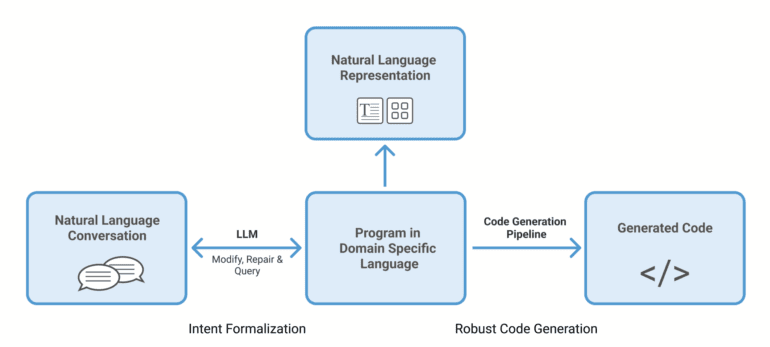TL;DR:
- Microsoft’s PwR introduces a new approach to software development, combining AI and developer expertise.
- PwR utilizes a domain-specific language (DSL) with built-in guardrails for enhanced safety and reliability.
- Large language models (LLMs) interpret user conversations, reducing code generation and increasing accuracy.
- PwR provides a natural-language representation (NLR) for developers, making coding more accessible.
- It empowers non-technical domain experts and enhances productivity for complex software engineering teams.
- A real-world application example showcases PwR’s potential in NGO projects.
- Microsoft aims to offer PwR Studio as an open-source IDE for conversational software development.
Main AI News:
In a rapidly evolving technological landscape, the future of software development is being redefined by the integration of artificial intelligence (AI) into the coding process. A vision where AI takes the lead in writing code while humans oversee and guide the process is becoming increasingly plausible. This transformative shift raises fundamental questions about how we can enhance developer productivity, ensure software safety, reliability, and maintainability, all while personalizing software development to cater to individual developer preferences.
The Challenge of AI-Developer Collaboration
To achieve this vision, it is essential for AI and developers to establish a common understanding. While natural language can facilitate interaction between AI and developers, it also presents challenges, such as potential misinterpretation of tasks. Current solutions often require developers to inspect, edit, and approve AI-generated code, demanding both domain expertise and coding proficiency. The need to bridge this gap is crucial for enabling a broader audience, including those without extensive coding skills, to participate in software development.
Introducing Programming with Representations (PwR)
Programming with Representations (PwR), pronounced “power,” is an innovative software development approach set to revolutionize the industry. Presented at the Agami Summit 2023, PwR leverages a domain-specific language (DSL) or representation, defined by domain experts, to provide a structured framework for software development. This DSL includes built-in guardrails that are automatically enforced throughout the development process, enhancing software safety.
PwR employs large language models (LLMs) to interpret user conversations and convert them into DSL programs. By reducing the code generated by LLMs, PwR increases accuracy, mitigating issues like hallucinations and limited context windows that LLMs may face. The DSL’s built-in guardrails, such as workflow states, defined transitions, and error handling protocols, help ensure essential components are present and can be automatically communicated back to developers in natural language for corrections.
One of the key advantages of PwR is that it doesn’t require developers to learn a custom DSL. Instead, it generates a natural-language representation (NLR) of the DSL, allowing developers to interact with a familiar language while preserving the precision of their intent within the underlying DSL. Furthermore, developers can access a live test environment within the PwR Studio tool, facilitating efficient testing and development.
Empowering Non-Technical Experts and Complex Teams
PwR significantly lowers the programming barrier, making software development accessible to non-technical domain experts, such as teachers, who can create tailored software solutions to address their specific needs. Additionally, it enhances productivity for complex, multidisciplinary software engineering teams, enabling them to handle large volumes of changes efficiently.
A Real-World Application: Welfare Scheme Application Development
To illustrate PwR’s practical application, let’s consider the scenario of a non-governmental organization (NGO) developing an application to streamline citizen access to government welfare schemes. This complex task involves orchestrating multiple components with precision to handle user data and monetary transactions securely.
PwR allows developers to create a custom DSL for this project, encoding interconnected workflows comprising various tasks. These workflows can seamlessly interact with external APIs through plugins available in the PwR Studio store, simplifying the integration of external resources.
The Future of PwR
Looking ahead, Microsoft intends to provide PwR Studio as an open-source integrated development environment (IDE) for conversational software development. Their initial focus is on facilitating workflow-based applications for NGOs and social enterprises with limited access to technical expertise. However, the potential of PwR extends far beyond this scope.
In a world where AI is poised to democratize software development, safety and reliability must remain paramount. PwR embodies these principles by combining the expertise of a select few technical experts with the collaborative power of representation. Microsoft encourages the software development community to experiment with this approach and similar ideas to build safe and reliable AI-powered software. As we embrace the future of AI-driven development, PwR offers a promising path towards a more inclusive and efficient software development landscape.
Conclusion:
Microsoft’s PwR signifies a significant shift in software development, enabling a broader audience to participate and collaborate with AI, ultimately democratizing the field. This innovation has the potential to create a more inclusive and efficient software development market, where safety and reliability remain top priorities.

